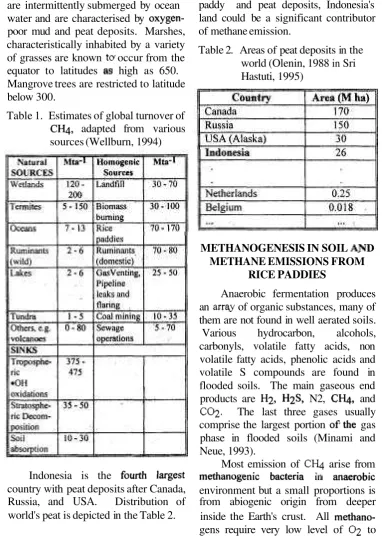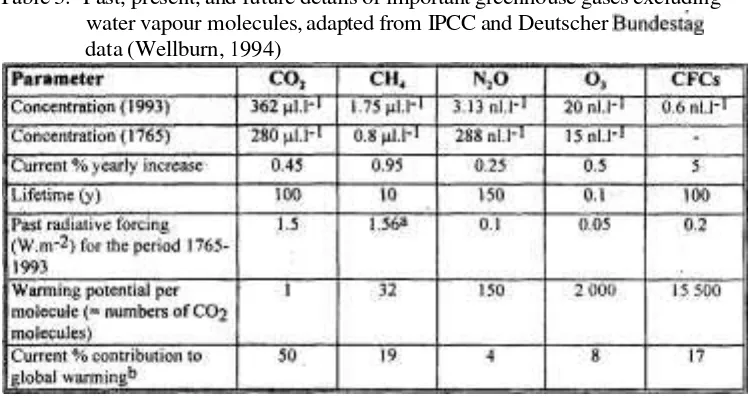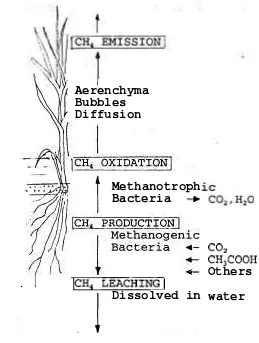12, No. 2, Agustus 1998
EMISSIONS FROM RICE AND PEAT SOIL
AND
CONTRIBUTION OF INDONESIA TO GLOBAL WARMINGSabdo
SOURCES OF METHANE Rice fields are considered to be among the highest sources of atmospheric methane, an important source of global warming. In order to meet the projected rice needs of the increasing world population, it is estimated that the annual world's rough rice production must increase to 760 million tons (a 65% increase) in the next 30 years. This will increase methane emissions from rice fields if current technologies are kept (Minami and Neue, 1993).
Indonesia, a country of which rice is one of its staple foods, produces 43.2 M tons of rice per year (Indonesia's Central Bureau of Statistics, 1992). It is produced from wetland paddy of 9.2 M ha and 1.2 M ha dry land paddy.
Total global and individual source emission estimates for methane remain essentially as presented in the IPCC First Assessment Report but with some individual changes. There has been a re-evaluation of some sources, particularly rice, and the additional sources such as animal and domestic wastes. A large portion of these emission comes from liquid waste handling systems. Uncertainties in global and regional emissions remain significant. A detailed analysis of new
information on rice suggests
emissions in the lower end of the 20
-
! range (Heinloth and
1993).
Different numbers of amount of could be met due to uncertainties and variation of measure- ment methods. According to Jarvis and Pain there are problems in obtaining reliable, reproducible measu- rements of the rates and extent of processes responsible for emission of and gases. This is, firstly, because of the difficulty in
the relatively small change in back- ground atmospheric concentrations of gases that result fluxes agriculture; secondly, because of the major spatial and temporal variability that exists; and, thirdly, because of interactive effects between the various components of the
atmosphere continuum.
Level of produced as a result of human activities are three to four times greater than those from natural sources. Of these, current estimates of the amounts of released rice paddies are the greatest and are still being revised upwards as more Chinese information becomes available (Wellburn, 1994).
One of the sources of atmospheric methane is wetlands. Thurman (1990)
Dept. of Agricultural Engineering, Faculty of Agric. Technology,
PERTANIAN
divides two types of wetlands, salt marshes and mangrove swamps. Both are intermittently submerged by ocean water and are characterised by
poor mud and peat deposits. Marshes, characteristically inhabited by a variety of grasses are known occur from the equator to latitudes high as 650. Mangrove trees are restricted to latitude below 300.
Table 1. Estimates of global turnover of adapted from various sources (Wellburn, 1994)
Considering Table and 2 depicted above and area of Indonesia's wetland paddy and peat deposits, Indonesia's land could be a significant contributor of methane emission.
Table 2. Areas of peat deposits in the world (Olenin, 1988 in Sri Hastuti, 1995)
METHANOGENESIS IN SOIL METHANE EMISSIONS FROM
RICE PADDIES
Anaerobic fermentation produces an of organic substances, many of them are not found in well aerated soils. Various hydrocarbon, alcohols, carbonyls, volatile fatty acids, non volatile fatty acids, phenolic acids and volatile S compounds are found in flooded soils. The main gaseous end
products are N2, and
The last three gases usually comprise the largest portion gas phase in flooded soils (Minami and Neue, 1993).
Most emission of arise from Indonesia is the
country with peat deposits after Canada, environment but a small proportions is Russia, and USA. Distribution of from abiogenic origin from deeper world's peat is depicted in the Table 2. inside the Earth's crust. All
12, No. 2, Agustus 1998
form but they grow well over a wide range of temperature and pH levels (Wellburn, 1994).
The mechanism in all, however, is very similar, The substrate
binds to a five-membered carbon ring structure (a and is then progres- sively reduced through (HCO-),
methenyl methylene and
methyl stages, finally releasing (Wellburn, 1994).
According to Minami and Neue there are five processes (diffusion, oxidation, mass flow into ground water, ebullition, plant mediated transport) governing the release of produced in the soil to the atmosphere.
METHANE AS A GREENHOUSE GAS AND THE GLOBAL
WARMING
Methane plays an important role in
the of the troposphere
and the stratosphere and a change in its concentration exerts a strong influence
the atmospheric chemistry (Thomp- son and Cicerone, 1986 in Minarni and Neue, 1993).
Like and Nitrous
Oxide methane is also an
important greenhouse gas that traps part of the thermal radiation from earth's surface. (Wang et 1976 in Minami and Neue, 1993).
Methane significantly contributes to global warming. The increasing
of accounts for
almost 20% of the radiative added to the atmosphere (Watson 1990 in Minami and Neue, 1993).
The predominant C02 contributes about 50% to overall warming but the others are important because all of them are more efficient absorber of IR than C02 (Wellburn, 1994).
Methane levels in atmosphere are arising as a result of various human activities. Currently, atmospheric con- centration is around 1.75
FURTHER CONSIDERATIONS
IPCC (Intergovernmental Panel on Climate Change) report reveals that if no measures are taken major climate changes could occur in the century. The available evidence compiled by the IPCC also shows that the projected measures, methane emission are likely to continue to increase from each source. This is because increased production from livestock and rice are required to feed the expanding world population. Current emissions for animal, rice, and animal wastes could grow by about 50-60% and 40% respectively by 2025.
Referring to the phenomenon of global warming, a temperature increase of the magnitude of 0.3
-
0.6 has occurred over the past century and a rateof warming 0.5 1.0 per
decade could be through the next few decades (IPCC
KETEKNIKAN
lead to severe impacts on agriculture
and forestry such as and
Karimanzira, 1993):
A shift of the climatic zone by several hundred kilometres towards the poles, thus enlarging the arid zones in the tropical and subtropical regions, and reducing the land available for agriculture.
rise in sea level of about 0.3 m, inundating valuable land in coastal areas, especially in tropical and subtropical zones.
gradual breakdown of many ecosystems like the forests in
temperate and boreal regions, leading to additional C 0 2 emissions and thus to further greenhouse warming. Uncertain effects of fertilisation and climate change on cycles of pests and weeds.
With the inevitable increase in human population, the quantity of methane in the atmosphere will increase. Unfortunately, in the most parts of the world, biogas has not yet been harnessed to convert methane into a major energy resource. Instead, it is freely discharged into the atmosphere and increase the concentration of the greenhouse gases. There is a need to devise ways of extracting some of these gases from the atmosphere by conven- tional means for commercial purposes (Olmdo, 1992).
Methane emissions from rice cultivation may potentially be reduced whiles maintaining or enhancing productivity. Mitigative practices may include modifying water depth and timing of irrigation, the type, rate, and application method of fertiliser, alter- native cultivation technology, and
cultivar selection. Much research is still required in order to realise these opportunities, and therefore a short-term reduction of methane emissions from rice growing cannot be expected. However, over a number of decades, although rice production may be doubled, an integrated management approach may succeed in reducing methane releases by 20-40 % (Heinloth and Karimanzira, 1993).
There are some efforts being done by Indonesia in accordance with methane emission reduction,
1. Intensification of paddy cultivation.
2. Developments of paddy
cultivation.
3. Diversification of staple foods in order to reduce rice consumption. . 4. Research on utilisation of peat as a
household energy resource.
REFERENCES
Heinloth, K. and Karimanzira, R. P. 1993. Outcomes and policy recom- mendations from the
working group on climate change response strategies and emission reductions in White, D. H. and S.M. (Eds). Climate Change: Significance for Agriculture and Forestry. Systems Approaches Arising from an IPCC
Meeting. Academic
Publishers, Dordrecht.
Indonesia's Central Bureau of Statistics. 1992. Statistical Pocketbook of Indonesia. BPS, Jakarta.
Vol. 12, No. 2, Agustus 1998 White, D.H. and S.M.
(Eds). Climate Change: Signifi- cance for Agriculture and Forestry. Systems Approaches Arising from an IPCC Meeting." Kluwer Acade- mic Publishers,
Minami, K. and Neue, H.U. 1994. Rice paddies as a methane source in White, D.H. and S.M. (Eds). Climate Change Significance for Agriculture and Forestry. Systems Approaches Arising from an IPCC Meeting. Kluwer Acade- mic Publishers, Dordrecht.
Olindo, Perez M. 1992. Climate, Tropical Ecosystems and the Survi- vability of Species. Proc. the Second World Climate
Cambridge University Press, Cambridge.
Sri Hastuti, 1995. Peat Compaction Root Proliferation. Thesis. Faculty of Agricultural and Applied Biological Sciences, University of Gent Belgium.
Thurman, Harold V. 1990. Essentials of Oceanography. ed.
Publishing Co., Ohio.
Wellburn, R. 1994. Air Pollution and Climate Change: The Biolo- gical Impact. ed.
Scientific Technical, New
Table 3. Past, present, and future details of important greenhouse gases excluding water vapour molecules, adapted from IPCC and Deutscher
data (Wellburn, 1 994)
Radiative forcing is the difference between total incoming solar radiation (240 reaching the surface of the Earth radiation emitted back out into space. This is the amount of actual global warming. In the case of an extra 0.14 has been added so as to account for additional water vapour arising from the atmospheric oxidation of CH,.
KETEKNIKAN
Aerenchyma Bubbles Diffusion
Methanotroph Bacteria
.
I
Dissolvedin
Others
water


